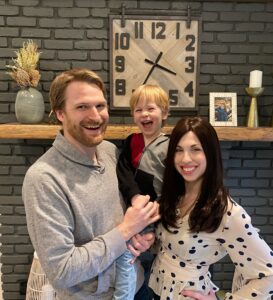Allison Elfreth
 Hi! I am Allison Elfreth and I have been teaching biology for over 10 years. I have my Master of Arts in Education from Teachers College Columbia University, my Master of Science in Biology from Tufts University, and I am a Doctorate of Education Candidate for Curriculum and Instruction in Science Education at Indiana University. I feel fortunate be able to work in a field that combines my two passions, science and education, and I have been wanting to extend my knowledge and experience to other professionals. I have had a particular interest in exploring methods for engaging all students through the implementation of providing meaningful feedback, using phenomena in the classroom, making learning and thinking visible, and employing the universal design for learning framework.
Hi! I am Allison Elfreth and I have been teaching biology for over 10 years. I have my Master of Arts in Education from Teachers College Columbia University, my Master of Science in Biology from Tufts University, and I am a Doctorate of Education Candidate for Curriculum and Instruction in Science Education at Indiana University. I feel fortunate be able to work in a field that combines my two passions, science and education, and I have been wanting to extend my knowledge and experience to other professionals. I have had a particular interest in exploring methods for engaging all students through the implementation of providing meaningful feedback, using phenomena in the classroom, making learning and thinking visible, and employing the universal design for learning framework.
In my free time I love to play with my three-year old son, take ballroom dancing lessons with my husband, cook, relax at the beach, explore Suffolk (as I grew up in Nassau), and spend time with friends and family.
I look forward helping other professionals in their educational goals and I hope you check out my course offerings!
Check out my course offerings:
Courses |
|---|
 Providing Meaningful Student Feedback in a Timely Manner Providing Meaningful Student Feedback in a Timely Manner(3credits/45hours) In-service credit only ON-LINE
Instructor: Allison Elfreth
Email: AElfrethliips@gmail.com
Course Description: The number of responsibilities a teacher has in a given day can be extensive, from writing up engaging lesson plans, putting in grades and attendance, responding to parent emails, attending CSE meetings, organizing after school club activities, developing effective assessments, and more. In addition to all of these responsibilities, we need to find some time to teach! But as any of us know, teaching does not just entail delivering a lesson for 40 minutes. We need to ensure our lessons are engaging all students, differentiated to meet the needs of all, and effectively preparing students to understand and apply the content they are learning. Part of that needs to include providing students with meaningful feedback. Feedback is “information provided by an agent regarding aspects of one’s performance and understanding” and is an essential part of the learning process. Feedback provides students with a clear understanding of the subject of interest; and if employed appropriately it not only gives students clear guidance for improving learning, but it also provides them with confidence. Of course, in order for feedback to be effective it must also be given in a timely manner; and therefore, we as teachers need to plan for providing feedback. We cannot expect that it is something we will just squeeze into our day. Instead, we need to be intentional about our feedback and carve out time for implementing feedback into our grading and into our lessons. Yet it is possible to make feedback a seamless part of everyday learning. John Hattie and Helen Timperley from the University of Auckland famously wrote The Power of Feedback in which they classify the purpose of feedback as “reducing the discrepancies between current understandings/performance and a desired goal.” We will use this reading, John Hattie’s principles of Visible Learning, and the online tool of GrokSpot as we delve into
• Characteristics of effective feedback and the three feedback questions
• The four levels of feedback and how feedback can improve self-efficacy and student confidence
• GrokSpot online tool for making feedback a seamless part of everyday learning
• Time-saving strategies for efficient grading feedback
• The use of rubrics to provide feedback and Google Classroom rubrics
• The benefits of peer- and self- assessment $250.00$280.00 Buy here |
 Using Phenomena-Based Learning in the Science Classroom Using Phenomena-Based Learning in the Science Classroom(3 credits/45 hours) in-service credit only
Instructor: Allison Elfreth Email: AElfrethliips@gmail.com
Course Description: Phenomena has been the new buzz word in education ever since Finland made Phenomena-Based Learning compulsory starting in 2016. At its core, phenomena-based learning is intended to be a cross-disciplinary form of teaching that enables students to understand the connections between multiple disciplines and how those disciplinary knowledges can be used together to solve problems. Practically, unless a school culture devotes itself to providing time in the day for students to participate in a multidisciplinary PhenoBL module as done in Finland, phenomena-based learning can and must be done in a given subject area. Phenomena are simply observable events, and they need not be phenomenal. The phenomena should have a real-world context which is how we can begin to engage all students. Similar to project-based learning and problem-based learning, students are expected to work together to ask questions and find solutions to those questions. We will explore the following
$250.00$280.00 Buy here |
 Universal Design for Learning to Engage All Students Universal Design for Learning to Engage All Students(3 Credits/45 Hours) In Service Credits only
Instructor: Allison Elfreth Email: AElfrethliips@gmail.com
Course Description: UDL, or universal design for learning, is a framework for teaching geared toward accommodating the needs and abilities of all learners. Using UDL, the learning goals are the same for all students while the teacher provides different ways for these goals to be achieved. UDL is not the same as differentiated instruction, as UDL proactively aims to provide options that makes the lesson accessible to all learners, differentiated instruction is a reactive process in which adjustments are made based on the individual’s needs. UDL is meant to remove the barriers to learning and encourage students to self-differentiate by choosing the best path for themselves. We will explore
• What Universal Design for Learning is and how it can engage all students
• How UDL develops expert learners
• Using BrainPOP as a tool for UDL
• Learner variability and the Myth of Average
• The multiple means of representation, engagement, and action and expression $250.00$280.00 Buy here |
